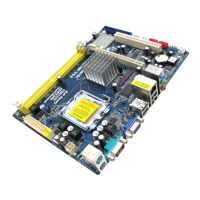
Do you have a question about the ASROCK G41M-VS2 and is the answer not in the manual?
| Non-ECC | Yes |
|---|---|
| Number of memory slots | 2 |
| Maximum internal memory | 8 GB |
| Processor socket | LGA 775 (Socket T) |
| Processor manufacturer | Intel |
| Compatible processor series | Intel® Celeron® |
| Number of Parallel ATA connectors | 1 |
| USB 2.0 ports quantity | 4 |
| Firewire (IEEE 1394) ports | 0 |
| Audio chip | Realtek ALC662 |
| Certification | FCC, CE |
| Power source type | ATX |
| Audio output channels | 5.1 channels |
| Motherboard form factor | micro ATX |
| Compatible operating systems | Win XP, Vista, 7 |
| Maximum graphics card memory | 1759 MB |
| Networking features | 10/100 Mbps |
| BIOS memory size | 64 Mbit |
| Depth | 170 mm |
|---|---|
| Width | 244 mm |
Lists items included with the ASRock G41M-VS2 motherboard package.
Details technical specifications of the ASRock G41M-VS2 motherboard, including CPU, Chipset, Memory, etc.
Illustrates the physical layout of motherboard components and connectors with numbering.
Describes the Rear I/O panel ports and the procedure for enabling Multi-Streaming audio function.
Instructions on how to use screw holes to secure the motherboard to the chassis.
Important safety and handling precautions before installing motherboard components or changing settings.
Step-by-step guide for installing an Intel 775-LAND CPU into the motherboard socket.
Instructions for installing the CPU heatsink and fan, including thermal interface material and connector.
Guide on installing DDR2 memory modules for dual channel configuration and proper seating.
Details the PCI and PCI Express slots and how to install expansion cards.
Explains the function and configuration of various jumpers on the motherboard, including PS2_USB_PWR1, Clear CMOS, and EUP jumpers.
Describes onboard headers and connectors like IDE, SATAII, and print port headers.
Guide to setting up SATAII hard disks for optimal performance by adjusting jumper settings for different vendors.
Steps for installing SATA/SATAII hard disks into the chassis and connecting data cables.
Instructions on how to install drivers from the support CD.
Explanation of the motherboard's Untied Overclocking Technology and its benefits for stability.
Introduces the BIOS Setup Utility and how to enter it.
Describes the main menu bar options available in the BIOS Setup Utility.
Explains the function of various navigation keys used within the BIOS Setup Utility.
Displays the system overview on the BIOS Main screen and how to configure system time and date.
Details the OC Tweaker screen for setting up overclocking features like CPU frequency and DRAM frequency.
Explains DRAM timing parameters like tCL, tRCD, tRP, etc., for performance tuning.
Describes settings for DRAM RCOMP STRENGTH for both channels, affecting performance.
Explains DRAM DLL SKEW settings for fine-tuning memory performance.
Options for adjusting DRAM voltage.
Options for adjusting Northbridge voltage.
Options for adjusting VTT voltage.
Options for adjusting GLTRef voltage.
Overview of the Advanced screen for configuring CPU, Chipset, ACPI, Storage, etc.
Utility for updating the system BIOS from Flash ROM.
Settings for CPU features like Halt State, Virtualization, Thermal Throttling, and Hyper-Threading.
Explains Intel SpeedStep technology for power saving by adjusting frequency and voltage.
Settings related to the chipset, including memory remapping, graphics adapter, and audio features.
Adjusts shared memory size for graphics when DVMT Mode is selected.
Configuration options for the onboard HD Audio feature.
Configuration options for the onboard HD Audio Front Panel.
Option to enable or disable the onboard LAN feature.
Details the Intelligent Energy Saver technology for power savings.
Settings for ACPI features like Suspend to RAM, Restore on AC/Power Loss, and power-on options.
Configuration for ATA/IDE and SATAII devices, including compatibility settings.
Settings for PCI/PnP configuration, including latency timer and IDE BusMaster.
Configuration for Super IO devices like serial and parallel ports, including addresses, modes, and IRQs.
Settings for USB controllers and USB 2.0 support, including legacy support options.
Monitors system hardware status like CPU temperature, fan speed, and voltages.
Configures boot settings and priority for available devices.
Settings for Full Screen Logo, AddOn ROM Display, and Boot From Onboard LAN.
Options for setting or changing supervisor/user passwords for system security.
Options for saving/discarding changes, loading defaults, and exiting the BIOS Setup Utility.
Information on supported Microsoft Windows operating systems for the motherboard.
Details about the contents of the support CD, including drivers and utilities.